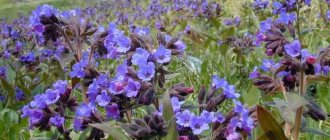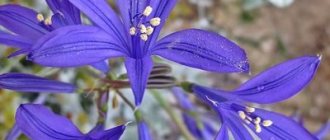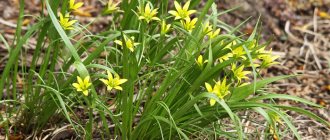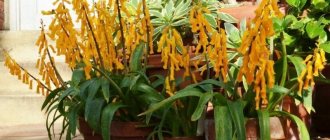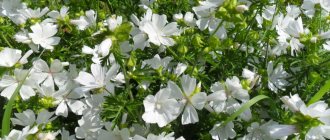The herbaceous annual plant is very popular among summer residents due to its decorative appearance, abundant flowering and ease of care.
Unlike tall perennial phloxes, Drummonda is a compact bush no more than 45-50 cm high, and some varieties reach only 30 cm.
The inflorescences, consisting of many buds, look very lush and delight with brightness throughout the summer. In the southern regions of Russia, the flowering of Drummond phlox continues even in the fall, until the onset of cold weather.
Dwarf varieties of the flower are used for decorating ridges and borders, and taller varieties of the crop are used for group plantings in mixborders.
The plant prefers moderate watering and loose, fertile soil in an area with good lighting. To preserve the decorative appearance of the flower bed, it is necessary to periodically remove wilted inflorescences.
Calibrachoa
Calibrachoa has significant external similarities to petunia, but they are different plants with different DNA structures. Calibrachoa is distinguished by a large number of small flowers with a “throat” of brown or yellow shades. The stem is branched, strong, with short hairs, early woody. The leaves are small and covered with hairs. Plant of ampelous type.
The following varieties have been developed by breeders:
- "Coral pink";
- "Kalita snow-white";
- "Cherry Star";
- "Apricot Punch";
- "Pink Chiffon";
- "Grape Punch"
Learn more about how to plant and grow Calibrachoa flowers.
Fuchsia ampelous
Fuchsia of the ampelous variety is a new, but already loved by many, flower with very beautiful and bright inflorescences. The simplest recommendations will help you enjoy its excellent appearance:
- location in partial shade;
- maintaining an increased level of soil moisture through frequent watering, spraying leaves in the heat. Excellent drainage at the bottom of the pot is required so that the plant in captivity does not lose its roots due to rotting;
- pruning shoots to give the bush the correct shape. It is simple to do: in the spring, the main branches are shortened by a third; while there are flowers, they are regularly pinched;
- fertilizing is an important element of the care program for any flowering plant. Any special complex compositions to improve flowering are suitable for ampelous fuchsia.
Minitunia
Minitunia is similar to petunia, only the small tiny flowers are so tiny that they cannot be confused with anything else. The plant is not tall, grows strongly and branches, forms strong shoots that are resistant to brittleness. Due to the abundance of buds forming on one bush, it resembles a colored cloud. Used in hanging flowerpots, as a groundcover and border plant.
[adsp-pro-4]
The most popular varieties:
- "Rose";
- "Rose Vane";
- "Blue Storm";
- "Ivory";
- "Coral Crash".
What flowers are similar to petunia and what are they called?
Petunia buds are shaped like a gramophone; depending on the variety, they have a smooth or wavy edge. Plant growers fell in love with the crop for its variety of colors and unpretentiousness. Unfortunately, it cannot fit into every landscape. Photos with names of flowers similar to petunias will help you choose a replacement for the popular plant.
Calibrachoa
These are ampelous flowers, similar to petunia, only their buds are small. Interestingly, until 1990, calibrachoas were considered one of the varieties of petunias; later they were classified as a separate species.
This is a plant with a powerful, woody stem at the bottom and long shoots. Their length can reach 1.5 m. The crown is spherical, densely covered with small buds.
The diameter of the bud does not exceed 3 cm, the core is almost always brown or yellow
The natural color of calibrachoa is purple, but thanks to the efforts of breeders, the plant, similar to petunia, has acquired a lot of other shades.
The culture does not tolerate direct sunlight and must be shaded during the budding period.
Minitunia
This is a variety of ampelous petunia, very similar to the main species. It is distinguished by small buds and short shoots. This feature makes the crown lush, completely strewn with inflorescences, behind which the green mass of the bush is hidden.
Minitunias are good to grow in flowerpots and flower pots, where they look especially impressive.
Mirabilis
It is a bushy flowering plant similar to petunia. Its height can reach 1 m. The leaves are obovate, dark green. Small buds from below stretch into a tube. Flowers of different colors can be located on one bush. Mirabilis blooms only at night.
The bud opens approximately after 16-00, at dawn it shrinks, in cloudy weather it can bloom all day
Surfinia
Flowers similar to petunia, created for growing in hanging structures, are called ampelous. Surfinia is classified as one of these species. This is one of the varieties of petunia.
Read more Why petunia seedlings die
Surfinia profusely flowering is an annual climbing plant. The buds are large, can reach 9 cm in diameter. The petals are richly colored, the throat is dark. Some varieties have contrasting veins or a white border along the edge of the petal.
In warm, humid climates, surfinia canes can grow 2 m in just two months
Surfinia has a long flowering period - from April to October. The plant is unpretentious, but prefers well-lit areas, abundant watering, and neutral soil composition.
morning glory
This is a vine plant, however, similar to petunia. It can grow up to 5 m. The shoots of the crop are poisonous, this should be taken into account when planting.
The buds are large, funnel-shaped, fragrant. The leaves are dark green, heart-shaped, densely covering the shoots. Morning glory blooms early in the morning and later turns to follow the sun. The color of the inflorescences is very diverse.
Morning glory blooms for a long time, begins with the arrival of summer, ends only with the onset of frost.
Lavatera
This crop is similar to petunia, only smaller. Lavatera has a developed root system, strong shoots and a rounded lush crown. The diameter of the flowers does not exceed 8 cm, the color is very diverse. They grow singly or in several pieces, forming in the axils of the leaves.
Lavatera cut flowers stay fresh for a week
The plant is unpretentious and can withstand drought, temperature changes, and strong gusts of wind.
Fragrant tobacco
It is a bushy flowering crop with erect stems. The leaves are large, heart-shaped, dark green. The flowers are similar to petunia buds, large, more elongated, reminiscent of a funnel.
A distinctive feature of fragrant tobacco is that the buds open only in cloudy weather.
Kampsis
This flowering crop is similar to petunia, but belongs to the genus of lianas. Its stem is gradually covered with thin bark. Blooming Kampsis looks impressive thanks to its large buds, shaped like a gramophone. They are collected in large inflorescences of 10-15 pieces.
Jagged foliage densely covers the plant, it is bright green and juicy. The crop can also be grown in northern latitudes if you care for it properly.
Campsis flowers open gradually, so its flowering period is quite long.
Siningia
This is a herbaceous perennial whose flowers are similar to petunia in shape and color. More than 70 species of syningia can be found in the natural environment.
The root system consists of a tuber that grows in size every year. It produces short, strong, dark red stems. The leaves are large, oval, dark green, their surface is velvety.
Read more Powdery mildew on petunia: how to fight, how to treat, photo
Large, single, bell-shaped flowers form at the ends of the stems. Depending on the variety, the buds can be painted in different colors.
You can grow syningia from seeds; an adult plant is obtained within a season.
Thunbergia
This plant with flowers similar to petunia can grow as a climber and shrub. The leaf is large, often reaching 10 cm in length, light green, its surface is velvety, slightly pubescent.
The flowers are similar to petunia, but small, their diameter does not exceed 4 cm. They can grow singly or form in inflorescences. The color of the buds is varied: blue, yellow, purple, orange. There are even rare species with red inflorescences.
Thunbergia can be grown as a garden or indoor plant.
Datura common
This petunia-like plant has poisonous properties. The culture has a powerful root system, a strong, erect stem, the height of which often exceeds 1.2 m. The flowers are single white or purple, funnel-shaped, and have an unpleasant odor. Their diameter can reach up to 12 mm. Flowering continues all summer - from early June to September.
Datura common is a heat-loving plant that grows in tropical and subtropical climates.
Brugmansia
Another crop whose flowers are similar to petunia. The perennial can take the form of a bush or small tree. Its crown is wide and dense. The leaves are large, branched, pubescent. Their length can reach up to 30 cm. They are arranged in tiers on the shoots.
Flowers are simple, double or two-tiered. They emit a strong, pleasant aroma that intensifies at night. The buds are impressive in size, in rare cases their length can reach 50 cm. The color is varied: white, orange, red, lilac.
The most fragrant brugmansia buds bloom in August
Flowering lasts from June to October. Afterwards, fruits filled with seeds are set.
Mirabilis
A plant of the Nyctaginaceae family called Mirabilis is a branching bush with ovate-elongated paired leaves. It has a unique feature - flowers of different colors may appear on one seedling, which bloom at night and fade by morning.
The flowers are fragrant, solitary, varied in color: from pastel to bright, one-, two- or three-color. The uniqueness of the flower is the absence of a corolla. The plant prefers sunlight and windless areas, fertile soil.
Of the 60 species, the Mexican mirabilis jalapa is widespread, several of its varieties are:
- "Iolanta";
- "Elvira";
- "Red Lollipop";
- "Mirabilis Serenade";
- "Mirabilis marble."
Read how to grow a Mirabilis plant in open ground.
Pelargonium thyroid (ivy leaf)
Due to its decorativeness and unpretentiousness, this flower may well become a worthy alternative to petunia. Bushes of the crop with shoots up to a meter long feel great even where there is little land - in pots or containers. The leaves, shaped like ivy, have been decorated with umbrella inflorescences of various colors and tones for quite a long time.
Caring for pelargonium is simple and easy. The plant is propagated by seeds and cuttings, planting them in fertile and light soil. The plant tolerates different conditions well, however, it also has a “weak spot”. Watering the pelargonium bush should be moderate, and the drainage at the bottom of the pot or flowerbed should be good. To prevent the leaves from rotting, you should avoid spraying and washing the shoots.
To ensure long and abundant flowering, it is enough to use regular potassium-phosphorus fertilizer. In summer, pelargonium can be safely kept in sunny places - it rarely suffers from heat, because originally from Africa.
Surfinia
The effectiveness of this hanging plant, which is considered a petunia hybrid, amazes many gardeners. Long, powerful stems and abundant flowering are the distinctive characteristics of surfinia.
[adsp-pro-5]
The color range is represented by a wide palette from white to purple. The flowers are bright and form a blooming ball. Today there are more than 20 varieties of surfinia.
Particularly popular:
- "Hot Pink";
- "Table White";
- "Yelou";
- "Giant Parple";
- "Surfinia Red".
We offer you to read an article about the care and cultivation of the Surfinia hybrid.
Top 5 annuals similar to petunia
There are quite a lot of such flowers. Although they are similar in appearance to petunias, they may differ in care rules, planting method, inflorescences or bush shape. Therefore, they will be an excellent replacement in areas where petunia itself does not take root. Sometimes this may be due to the composition of the soil or climatic conditions.
Surfinia
A hybrid of petunia, but it has a longer flowering period (from April to cold weather) and branched stems. It has a variety of colors - from white to purple. Grows up to two meters. The diameter of the flower itself is 5-6 cm. It is unpretentious, but to obtain a lush bush you will have to adhere to several criteria:
- good lighting;
- temperature not lower than 10-15 degrees;
- periodic, abundant watering;
- neutral soil composition;
- application of mineral fertilizers in spring and autumn;
- timely pruning of shoots;
- protection from winds and rain.
Calibrachoa
Does not tolerate hot sunlight. Therefore, when the sun is shining, the plant must be shaded. Otherwise, calibrachoa will die. Flowers in the form of bells of various shades. Many people confuse it with petunia. Indeed, they have a related origin, but genetically they are different - petunia is simpler. Calibrachoa flowers are small - 1-3 cm in diameter. The rigid stems reach 1-1.5 m in length and are completely covered with bells. Propagated by cuttings or seeds. The heat-loving flower does not tolerate sharp gusts of wind. Maintenance is simple, the main thing is not to water too often, spray and fertilize on time.
The natural color of Calibrachoa flowers is purple.
Minitunia
Another petunia hybrid, but its inflorescences are small. It has small stature, branched and strong shoots. Blooms profusely - resembles a cloud of blue, pink and yellow shades. It will bring zest to landscape design with its bright appearance. Can be used for borders, flowerpots, lawns. Sometimes also called small varieties of petunias.
Lavatera
Easy to care for, drought-resistant and frost-resistant. Light-loving, but develops well in the shade. It is not demanding on the composition of the soil. Reaches a height of 1 m 20 cm. It is distinguished by angular, voluminous foliage. It is complemented by spectacular flowers of two types: racemose and single. Suitable for growing in the garden (near trees), flower beds with several types of flowers and creating an independent composition. Requires installation of support and garter.
Mirabilis
Compact-sized bushes grow up to 70-80 cm. In rare cases, Mirabilis is found 1 m high. The branches are straight and dense, the foliage is elongated, the rhizome resembles a carrot. Color: yellow, orange, lilac, crimson. There are spotted, striped and multi-colored varieties. Flowering continues until late autumn. At the same time, a sweet aroma comes from the plant. For planting, choose a well-lit, warm place without drafts. Not picky about soil composition.
Mirabilis does not require special care, but it does require regular loosening of the soil and timely watering. Keep in mind that the flower does not tolerate stagnation of water.
Now all that remains is to choose the plant you like and plant it on your plot or loggia. Some of the flowers shown are perennials in their natural environment. But it is in Russia that they are grown as annuals. This is due to the climate of the country.
morning glory
Morning glory is a genus of plants in the bindweed family. Poisonous climbing vine (up to 5 meters) with heart-shaped leaves, large funnel-shaped flowers of various shades. Morning glory gramophone flowers vaguely resemble petunia. The most common genus is the sweet potato morning glory, which includes five hundred species.
Of the 500, twenty-five are used in floriculture, the most popular of which are:
- "Ipomoea Cairo";
- "Ipomoea sky blue";
- "Ipomoea purpurea";
- "Ipomoea Nile";
- "Ipomoea moonflower."
Find out more about growing perennial Morning Glory outdoors.
Datura
Datura is a genus of plants in the nightshade family. An annual plant with a bare erect stem, about 1 meter high, forms a bright bush with huge gramophone flowers.
Datura leaves differ from petunia leaves in that they have dark green and lighter shades. The flowers are solitary, large, located in the forks of the stem. The flower is unpretentious, but responds gratefully with abundant flowering on fertile soil.
Attention. Datura is a poisonous plant that can intoxicate. Symptoms of poisoning may occur with prolonged close contact.
Varieties that are relevant to gardeners:
- "Common Datura";
- "Indian Datura";
- "Brugmansia";
- "Datura blizzard."
Read about how to grow dope from seeds in your garden.
Verbena
Long grown everywhere, verbena continues to be popular today. It is quite possible to choose the sunniest place for this plant - there the bush will grow beautifully, abundantly producing fresh inflorescences. During their growth period, verbena is fed with mineral compounds, and the bushes themselves are regularly removed from dried and diseased shoots. The crop is propagated by cuttings.
Are there any special features when caring for verbena? Yes, the only difficulty is maintaining the watering regime. In no case should it be abundant - this provokes powdery mildew. At the slightest dryness, verbena drops its flowers, which is undesirable. Therefore, the best option for it can be considered fairly frequent, but moderate watering. To preserve flowers, you can cover the soil around the stems with moss or coconut fiber.
The listed plants are relatively easy to care for, and the beauty of their flowers is in no way inferior to the beauty of petunia. However, for those who have no time to work with flower beds, they most likely will not be suitable. For such people, we can recommend nasturtium, a crop that requires virtually no human help during its growth. It is not only as unpretentious as possible, but also beautiful, original in appearance, and with its help it will be possible to transform even the most unsightly area.
Lavatera
Delicate pink, white and purple flowers with a silky tint make it difficult to confuse Lavatera with any other garden plant, even petunia. These are malt varieties. The leaves are spade, have hairs, the flowers are large, the buds create spikelet inflorescences.
[adsp-pro-6]
Has a long flowering period. The whole advantage of this flower is that it is not picky about the soil and is resistant to drought and wind.
Florists use two types:
- Lavatera annual (Silver Cap, Mont Blanc, Lovelines, Pink Beauty, Ruby Queen).
- Lavatera perennial (Lilak, Lady Bregon, Springs, Burgundy Vine, IKatcher).
We invite you to read an article about how to grow Lavatera from seeds on your own plot.
Diseases and pests
You can start counting 7 days after planting the seedlings and until August. Moderate watering is required, since the flower does not favor waterlogging of the soil. Like any plant, petunia can carry a number of diseases and fight off pest attacks. If poorly cared for, a flower may suffer from :
- Wet and gray rot . A sign of the disease will be the appearance of light brown spots on flowers, leaves and stems, which over time become covered with a gray fluffy coating. The main cause of the disease is low temperature, high air humidity, and excess nitrogen in the soil. To avoid disease, dense planting should not be allowed. It’s a pity, but a sick plant will no longer be able to recover. The soil from it is not used for planting another flower.
- Aphids . You can use insecticides or treat the plant under a strong stream of water.
- Powdery mildew . May occur due to sudden temperature changes and high humidity. It is expressed in the fact that the leaves and flowers are covered with a white coating. In this case, unhealthy areas of the plant are removed, after which the flower is treated with sulfur.
Brugmansia
Brugmansia is a genus of plants from the nightshade family. In summer it is covered with an abundance of flowers, which are called “angel trumpets”.
Attention! This is a poisonous shrub. The abundance and intensity of its aroma causes headaches, and toxic substances cause hallucinations.
Stems are woody, covered with smooth bark. The main asset of the plant is its spectacular flowers. The petals can be of various shades: white, cream, scarlet, yellow, blue.
Popular varieties:
- "Fragrant Brugmansia";
- "Golden";
- "Snow White";
- "Bloody";
- "Colorful Brugmansia"
Read about growing Brugmansia in open ground.
Fragrant tobacco
Tobacco is a genus of perennial and annual plants of the nightshade family. The bush is erect, branched, the leaves are large, dark green. The flowers are funnel-shaped, large, white, yellow or green, open in the absence of sun.
The flower prefers fertilized soils well supplied with moisture. Resistant to pests and diseases, able to repel pests from plants adjacent to the garden.
Many varieties have been developed that have a wide variety of colors:
- "Pink";
- "Raspberry red";
- "Lilac";
- "Lemon green."
Read how to care for and grow fragrant tobacco.
Original or copy?
There are quite a lot of plants similar to this beauty, and they also have their fans. In order not to get confused in the variety of similar plants, you need to know their distinctive features. Among the “doubles” of petunias you can most often find plants, which will be discussed below:
- Calibrachoa. This is the name of an ampelous flower, which is very similar to petunia in appearance, but differs from it in its DNA structure. Its flowers are smaller than those of the original, and have a so-called neck and cover the plant in large quantities. The color palette is not very diverse - mainly shades of brown and yellow. The stems of Calibrachoa are branched, strong, and fleecy;
- Minitunia . Most often used as a groundcover or border plant. It is distinguished by strong branching, a large number of buds, which then turn into small flowers, and then become strong, break-resistant shoots;
- Mirabilis. This is a branching bushy plant, the paired leaves of which have an ovate-elongated shape. It has one interesting feature: flowers of different colors can appear on the same bush. They open at night and wither in the morning. When choosing mirabilis, you should remember that this plant must be planted in sunny areas, sheltered from the wind. The soil must be fertile;
- Surfinia. A very beautiful plant, which when flowering becomes like a flower ball - it is so densely covered with bright buds.
- Morning glory . Attracts with large funnel-shaped flowers and leaves resembling hearts. But this beautiful liana, which can grow up to 5 m in length, is poisonous, and you need to remember this when choosing it for your site.
- Datura. These are erect annual plants that form a bush. The flowers are single, large, located in the branches of the stem.
Datura is unpretentious, but poisonous, as its name itself suggests, so it must be handled with care.
- Lavatera. It is distinguished by spectacular flowers, which are presented in pink, white, purple shades, while they are cast with silk. The leaves are spade-shaped and hairy. Blooms for a long time.
- Brugmansia. The stems of this plant become covered with bark over time. The unusual color of the flowers (petals of different shades) attracts attention.
- Fragrant tobacco. These erect, branchy bushes are familiar to many. Tobacco leaves are large and dark green in color. The flowers are rather large and resemble a funnel. A distinctive feature of this plant is that it blooms only in cloudy weather.
Thunbergia grandiflora
Thunbergia is a herbaceous climbing plant of the Acanthaceae family. This spectacular vine grows up to six meters, develops quickly, is unpretentious in care, but requires support. The inflorescences of purple, yellow, white, bright orange or bright crimson are admired.
Popular types of vines:
- “Thunbergia grandiflora or blue”;
- "Battiscombe's Thunbergia";
- "Thunbergia winged."
All about growing Thunbergia from seeds in the full article.
Kampsis
Campsis is a woody deciduous vine. The main valuable advantage of this heat-loving plant is the abundant flowering of gramophone buds. The foliage is imparipinnate, varied in color: pink, orange, red, crimson.
[adsp-pro-7]
The plant prefers soil rich in minerals and trace elements. From the species of Kampsis rooting and Kampsis grandiflora, breeders developed a third species - Kampsis hybrid.
Indoor syningia
Siningias differ from petunias in that they have a velvety flower that looks like a bell. This is a tuberous houseplant, herbaceous and low growing. The rhizome is tuberous, the leaves are thick, velvety, the flowers are bell-shaped.
The leaves are 15–20 cm long, oval, covered with fluff, with scalloped edges, arranged in a rosette. From April to August, large gramophone flowers, white, pink, and purple, appear on long peduncles. Needs plenty of light, but direct rays should be avoided.
Current varieties:
- "Gregor Mendel";
- "Duchess of York";
- "Mont Blanc"
- "Champers"
- "Brocade";
- Avanti.
Reproduction of Calibrachoa
Calibrachoa is propagated using rooted cuttings, that is, vegetatively. This does not mean that the plant does not set seeds - it does so willingly, but... The problem is that calibrachoa from seeds often grows not like its “parents”. In other words, in its development it “slides down” to the “wild” variants of calibrachoa, from which the hybrid mother plants were created. Calibrachoa grown from seeds may bloom sparsely, and the flowers may be a completely different color, smaller in size, etc. Although, you may be lucky - calibrachoa from seeds will repeat the mother plant, but this will most likely be an exception to the rule.
A win-win option is to propagate calibrachoa by cuttings. To do this, at the end of summer or early autumn, cut the apical cuttings 4-5 cm long from the mother plant. Tear off the lower leaves and plant the bare part of the stem in light, moist soil. In order for the Calibrachoa cuttings to take root, they are placed in a “greenhouse”. The easiest way is to cover the planted cuttings with a plastic cup and open it slightly every day for a few minutes for ventilation.
In conditions of high humidity in the greenhouse, Calibrachoa cuttings quickly take root.
After this, the “greenhouse” can be removed and the cuttings can be cared for as for ordinary indoor plants. They are completely unpretentious and survive the winter without loss. In the spring, the apical cuttings are cut off from the grown bushes a second time and rooted again - from which flowering calibrachoas are grown. In contact with
Streptocarpus
The appearance of about a hundred flowers on bushes at the same time is the norm for streptocarpus. The formation of a large rosette of leaves is characteristic; the inflorescences are dense. The stem, unlike petunia, is absent. Wrinkled, dark green, oval-shaped leaves.
The corolla resembles a bell with six petals. The color is plain or variegated: all shades of pink, white and blue.
More than one hundred and thirty species of Streptocarpus have been registered, but decorative varieties are popular:
- "Streptocarpus rocky";
- "Streptocarpus rex";
- "Streptocarpus Wendland".
Find out more about growing Streptocarpus at home.
Cascade
Cascade petunias are also called semi-ampeloid (subspecies). Unlike real ampels, their stems are stronger and at first grow upward, forming a cap of leaves. The stems of cascading forms reach a length of 1.5 m, and begin to fall down only when a certain amount of green mass has been gained. Flowers of the same size are formed on the plant - 4-5 cm.
Interesting series of cascading garden petunias
| Name and description of F1 hybrids | Photo |
| Bravo – abundant flowering, compact form | |
| Flash – large flowers in a wide range of colors, strong growth | |
| Fantasy - small flowers, compact shape, low stature | |
| Hurrah – large flowers, wide range of colors, compact shape | |
| Parade Plus - regular spherical shape | |
| Daddy - large veiny flowers | |
| Focus/Marathon – abundant flowering, vigorously propagating plants, compact form | |
| Fantasy – small flowers, dwarf plants for pots, hanging baskets | |
| Conchita - a variety with hanging shoots, small leaves, numerous simple or double flowers of medium size |
Phlox drummond
The annual forms a bush with a branched stem with opposite oval-lanceolate leaves. The flowers can be salmon, yellow, white, dark red or purple.
They grow best in partial shade, the color saturation remains for a long time, and the inflorescences do not fade. For modern gardeners, Drummond phlox is an attractive plant, preferred for flower beds, mixborders, and special portable containers.
Varieties:
- "Promise Pink";
- "Constellation";
- "Shimmering Star";
- "Star Rain".
Impeller balsam
This plant became popular not so long ago, however, now it is highly valued by almost all experienced gardeners. Luxurious inflorescences of white, pink or red flowers come in simple, semi-double or double. They are often so numerous that they obscure the leaves. Flowering, as a rule, lasts a long time: having begun in June, under suitable conditions (transferred indoors) it can continue into winter. An ideal life for a bush can be created by placing it in partial shade and regularly, without delay, watering and spraying. In order for balsam to bloom profusely, it is planted in a small pot and fertilized with any factory-made composition.
